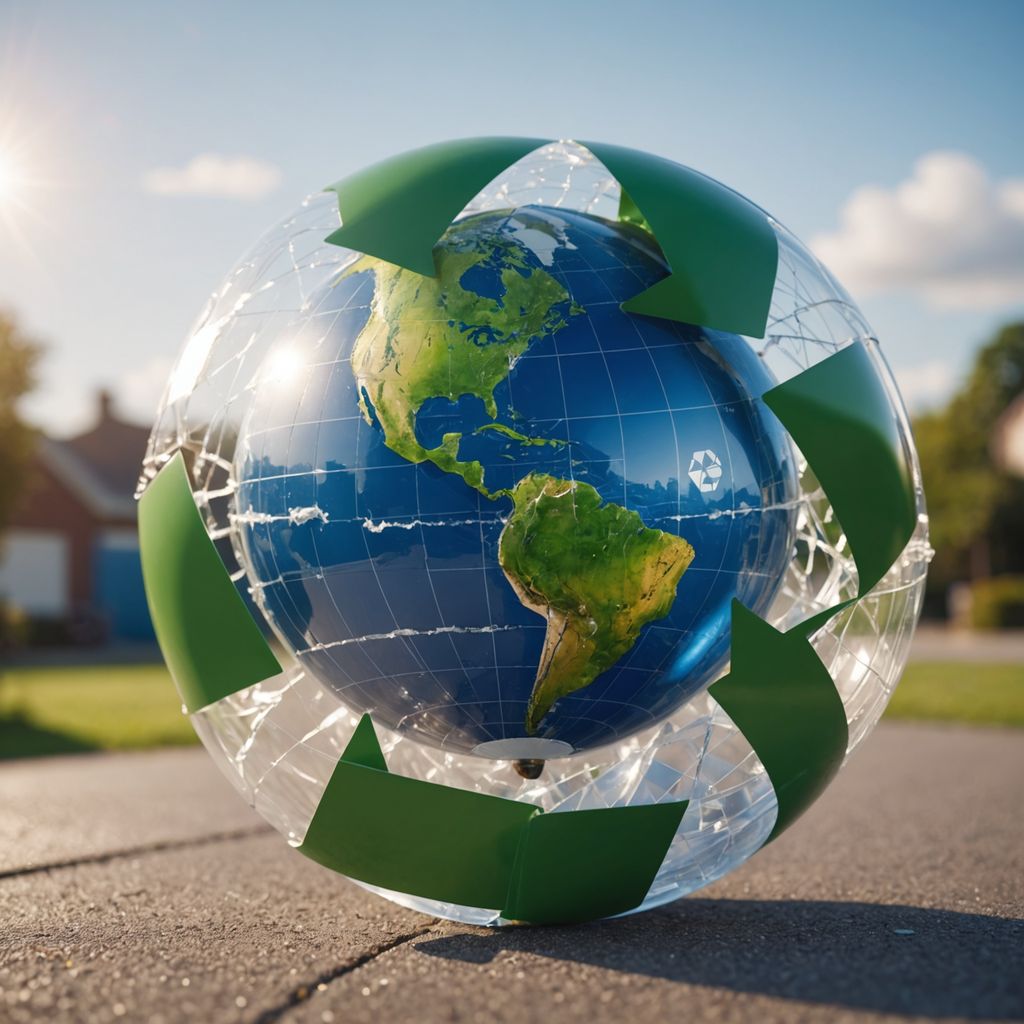
Reducing Single-Use Plastic: Climate Change Effects
Share
Single-use plastics are everywhere, from water bottles to shopping bags. While they are convenient, their impact on the environment is huge. Plastics take hundreds of years to break down, and during this time, they release harmful chemicals and greenhouse gases. Reducing our use of single-use plastics is key to fighting climate change and protecting our planet.
Key Takeaways
- Single-use plastics contribute significantly to climate change by emitting greenhouse gases during production and decomposition.
- Reducing plastic consumption can start with small changes in our daily lives, like using reusable bags and bottles.
- Corporations and governments play a crucial role in addressing plastic pollution through innovative solutions and policies.
- Recycling systems face many challenges, but new technologies and community efforts are helping to improve plastic waste management.
- Global cooperation, including international agreements and grassroots movements, is essential to combat plastic pollution and its climate impact.
The Environmental Cost of Single-Use Plastics

Greenhouse Gas Emissions from Plastic Production
The production of single-use plastics is a significant contributor to greenhouse gas emissions. From the extraction of fossil fuels to the manufacturing process, each step releases a considerable amount of carbon dioxide and other harmful gases into the atmosphere. This cycle of pollution continues as these plastics are often incinerated, releasing even more emissions.
Impact on Marine Ecosystems
Single-use plastics pose a severe threat to marine life. These plastics often end up in oceans, where they can be ingested by marine animals, leading to injury or death. The presence of toxic chemicals in these plastics further exacerbates the problem, contaminating the food chain and affecting biodiversity.
Long-Term Decomposition and Pollution
One of the most troubling aspects of single-use plastics is their long-term impact on the environment. These materials can take hundreds of years to decompose, during which they break down into smaller particles known as microplastics. These microplastics persist in the environment, causing ongoing pollution and posing risks to both wildlife and human health.
Strategies for Reducing Single-Use Plastic Consumption
Individual Actions and Consumer Choices
Individuals can make a significant impact by adopting simple, everyday habits. Using a reusable water bottle and bringing a reusable bag to the store are easy steps. Avoiding overly packaged items, such as pre-cut fruits and vegetables, can also reduce plastic waste. Shopping at bulk food stores and repurposing old containers are other effective strategies. Cooking at home instead of ordering takeout, which often includes extra plastic packaging, is another way to cut down on single-use plastics. Additionally, using bar soaps and shampoos instead of liquids in plastic bottles can make a difference. For women, opting for period underwear for women can also reduce the reliance on single-use plastic products.
Corporate Responsibility and Innovation
Corporations play a crucial role in reducing single-use plastic consumption. By investing in sustainable packaging solutions and innovative materials, companies can significantly lower their plastic footprint. Many businesses are now exploring biodegradable and compostable alternatives to traditional plastic. Additionally, corporations can implement recycling programs and encourage consumers to return used packaging. Transparency in supply chains and corporate responsibility initiatives can further drive the shift towards a more sustainable future.
Policy and Legislative Measures
Governments and policymakers have the power to enforce regulations that limit the use of single-use plastics. Bans on plastic bags, straws, and other disposable items have already been implemented in various regions. Incentives for businesses to adopt eco-friendly practices and penalties for non-compliance can also drive change. Public awareness campaigns and educational programs can help inform citizens about the importance of reducing plastic waste. International agreements and collaborations can further strengthen these efforts, ensuring a global approach to tackling plastic pollution.
The Role of Recycling in Mitigating Plastic Waste
Challenges in Current Recycling Systems
Recycling faces numerous obstacles, including low rates of plastic recovery and contamination of recyclable materials. Only about 9% of all plastic waste has been recycled, highlighting the inefficiency of current systems. Additionally, the economic viability of recycling is often questioned, as the cost of reclaiming plastic can exceed the value of the recycled material.
Innovative Recycling Technologies
Technological advancements are crucial in tackling plastic pollution. Innovations such as biodegradable plastics, plastic-to-fuel technologies, and waste-to-energy solutions offer promising alternatives. These technologies can help reduce the environmental impact of plastic waste and provide more sustainable recycling options.
Community-Based Recycling Initiatives
Local communities play a vital role in recycling efforts. Community-based initiatives can increase recycling rates and promote environmental awareness. Programs that encourage sorting waste at the source and educating residents about the benefits of recycling can lead to more effective waste management and a reduction in plastic pollution.
Plastic Pollution and Its Contribution to Climate Change

Lifecycle Analysis of Plastic Products
The lifecycle of plastic products, from production to disposal, has a significant impact on climate change. Plastics are environmentally costly to make and dispose of, emitting greenhouse gases at every stage. The production process relies heavily on petrochemicals, which are derived from fossil fuels. This not only depletes non-renewable resources but also releases a substantial amount of carbon dioxide into the atmosphere. As plastics decompose, they continue to emit greenhouse gases, further exacerbating global warming.
Microplastics and Their Environmental Impact
Microplastics, the tiny fragments resulting from the breakdown of larger plastic items, pose a severe threat to marine ecosystems. These minuscule particles are ingested by marine organisms, including zooplankton, which play a crucial role in the ocean's ability to absorb carbon. The ingestion of microplastics by these organisms disrupts their normal functioning and can lead to a decrease in carbon absorption, thereby contributing to climate change. Additionally, microplastics can carry toxins found in Knix panties, which further harm marine life and ecosystems.
The Interplay Between Plastic Waste and Global Warming
Plastic waste and global warming are interconnected issues that exacerbate each other. As climate change intensifies, extreme weather events become more frequent, spreading plastic waste over larger areas and into previously unaffected regions. This widespread distribution of plastic pollution weakens marine ecosystems, making them less resilient to environmental changes. Furthermore, the degradation of these ecosystems reduces their ability to act as carbon sinks, thereby increasing the concentration of greenhouse gases in the atmosphere. The combined effect of plastic pollution and climate change leads to a vicious cycle that threatens the health of our planet.
Global Efforts to Combat Plastic Pollution

International Agreements and Policies
Addressing the issue of plastic pollution requires a multifaceted and concerted effort. While localized efforts are helpful, climate change and plastic pollution are global problems that often impact communities least equipped to deal with them. The UN Environment Programme is working to create an internationally-binding agreement focused on ending plastic pollution. Policy innovation and cooperation are needed at the international, national, and local levels to motivate plastic producers and consumers to choose alternatives.
Grassroots Movements and Activism
Many initiatives around the world aim to reduce plastic use and support sustainable practices. Often, these policies target single-use plastics, which are considered the worst offenders in terms of carbon and environmental damage. Grassroots movements and activism play a crucial role in raising awareness and pushing for change at the community level.
Philanthropic Support and Funding
Philanthropic organizations and funding bodies are increasingly recognizing the importance of combating plastic pollution. These entities provide essential resources for research, innovation, and the implementation of sustainable practices. Their support helps drive initiatives that might otherwise lack the necessary funding to make a significant impact.
The Future of Plastic in a Sustainable World

Biodegradable and Alternative Materials
The future of plastic hinges on the development and adoption of biodegradable and alternative materials. These materials are designed to break down more quickly and safely in the environment, reducing the long-term pollution caused by traditional plastics. Innovations in this field are crucial for minimizing the environmental footprint of plastic products. Researchers are exploring materials derived from natural sources, such as plant-based plastics, which offer a promising alternative to petroleum-based plastics.
Circular Economy Approaches
A circular economy approach aims to keep plastic products in use for as long as possible, extracting maximum value before recovering and regenerating materials at the end of their service life. This model contrasts sharply with the traditional linear economy, which follows a 'take, make, dispose' pattern. By rethinking product design, production processes, and consumption habits, a circular economy can significantly reduce plastic waste and its environmental impact.
The Role of Education and Awareness
Education and awareness are pivotal in driving the shift towards sustainable plastic use. Informing the public about the environmental and health impacts of plastic pollution can lead to more responsible consumer choices and increased support for policies aimed at reducing plastic waste. Schools, community programs, and media campaigns play a vital role in spreading this knowledge. Empowering individuals with the information they need to make sustainable choices is essential for fostering a culture of environmental stewardship.
Conclusion
In conclusion, reducing single-use plastic is essential for combating climate change. Simple actions like cutting down on plastic use, recycling correctly, and joining community clean-ups can make a big difference. By choosing products with less plastic and supporting eco-friendly businesses, individuals can drive change. Governments and organizations must also step up, creating and enforcing policies that limit plastic production and promote sustainability. The fight against plastic pollution and climate change is interconnected, and addressing one helps tackle the other. Together, through collective effort and smart choices, we can protect our planet for future generations.
Frequently Asked Questions
What is single-use plastic?
Single-use plastics are items meant to be used once and thrown away. Examples include plastic bags, straws, and water bottles.
How does plastic production contribute to climate change?
Making plastic releases a lot of greenhouse gases, which trap heat in the atmosphere and make the planet warmer.
What are some easy ways to reduce single-use plastic?
You can carry reusable bags, bottles, and containers. Also, try to buy products with less plastic packaging.
Can recycling help reduce plastic waste?
Yes, recycling can help, but it's not enough by itself. We also need to use less plastic and find better ways to manage waste.
What role do companies play in reducing plastic pollution?
Companies can make a big difference by using less plastic in their products and packaging, and by finding new ways to recycle.
Are there laws to help reduce plastic pollution?
Yes, some governments have made rules to limit plastic use, like banning plastic bags or requiring companies to recycle more.
